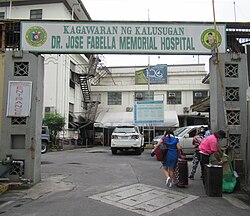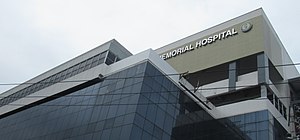

This article has multiple issues. Please help improve it or discuss these issues on the talk page. (Learn how and when to remove these template messages)
|
| Dr. Jose Fabella Memorial Hospital | |
|---|---|
| Department of Health | |
 | |

Facade of the Hospital
| |
|
Location in Metro Manila | |
| Geography | |
| Location | Lope de Vega Street, Santa Cruz, Manila, Philippines |
| Coordinates | 14°36′22″N 120°59′03″E / 14.606223°N 120.984202°E / 14.606223; 120.984202 |
| Organization | |
| Funding | Public hospital |
| Type | Specialist |
| Services | |
| Beds | 700 |
| Speciality |
|
| Public transit access | |
| History | |
| Opened | November 9, 1920 |
| Links | |
| Website | fabella |
| Lists | Hospitals in the Philippines |
Dr. Jose Fabella Memorial Hospital, the National Maternity Hospital, is a maternal and newborn tertiary hospital located in Santa Cruz, Manila in the Philippines. It also houses the Jose Fabella Memorial Hospital School of Midwifery, one of the best-performing institutions recognized by the Professional Regulation Commission in the Midwife Licensure Examinations. In 2015, the World Health Organization recognized the hospital "as a role model of the World Health Organization-Western Pacific Region Office for its essential newborn care programs, which have been proven to reduce infant morbidity and mortality".[1]
Dr. Jose Fabella Memorial Hospital started as a six-bed clinic called the "Maternity House" on November 9, 1920. The clinic, which was founded by then Chairman of Public Welfare Board, Jose F. Fabella, was originally located along Isabel Street in Sampaloc, Manila. It was taken over by the Public Welfare Commission the following year. In 1922, the clinic added a pediatric section and a school of midwifery. In 1931, the control of the clinic was handed over to the Bureau of Health and in 1947 to the Bureau of Hospitals. In 1951, the clinic moved to its present location at the Old Bilibid compound at Santa Cruz, Manila.[2]
Unlike other Philippine government hospitals, there was no legislative act that permitted the creation of the hospital. Its present location was only legitimized by Administrative Order no. 140, which was issued by President Manuel L. Quezon on February 19, 1941. The Administrative Order recommended that the Bilibid Hospital be used as a maternity hospital. On June 15, 1968, the Maternity and Children's Hospital was renamed Dr. Jose Fabella Memorial Hospital in honor of the hospital's founder. To date, it has an authorized bed capacity of 700.
The Jose Fabella Memorial Hospital School of Midwifery is housed within the hospital. It is a government institution managed by the Department of Health.
A building of the same name located at the Lung Center of the Philippines compound was erected to serve as temporary office of the hospital. A new building will then be erected under the proposed tri-medical complex in the DOH headquarters, where San Lazaro Hospital and Jose Reyes Memorial Medical Center are located. Find the inauguration video of new facility made operational. There have been some medical studies, conducted by the doctors of this hospital.
The hospital is considered a "baby factory" and ground zero of the Philippines’ overpopulation crisis. The reputation of the hospital as a baby factory is well justified as no other hospital in the country has a higher birth rate. The maternity ward at the hospital continues to overflow with hundreds of new mothers. There are not enough beds for everyone, so four or five mothers share one bed.[3] The hospital suffers from extreme heat during the summer.[4]
Fabella Hospital serves the greater Manila area of the Philippines. There have been times when some women make significant efforts to reach the facility even during severe weather conditions. This is due to its reputation for offering comparatively affordable maternity services. As compared to the other hospitals, this hospital is most rated and loved. However, there are potential challenges like congestion and high temperatures.
There have been occasional concerns regarding rumors of infant exchanges within the hospital's premises. It is vital to understand, that these rumors lack credible evidence. Hospital protocols ensure the attachment of identification tags to newborns' ankles and wrists immediately after birth, significantly reducing the likelihood of any mix-up. Mothers are also provided with corresponding ID tags to guarantee accurate maternal-child matching.
During the early 2000s, colloquial terms like 'baby factory' were occasionally used due to the notable presence of numerous staff members working in various areas of the hospital. In recent times, both the staff and patient numbers have increased. The RN Heals program has facilitated the addition of more staff, allowing them to collaborate with experienced professionals. Furthermore, the hospital's dedication to assisting newly graduated nurses through this initiative has enabled them to gain practical experience, serving as a foundational step in their careers.

Since it is a mother and baby care hospital, all wards cater to mothers and babies only.
Ward 1 is specifically for abortion, gynecology, and oncology cases.
Ward 2 is for high-risk mothers waiting to give birth and are under observation due to some common pregnancy complications like hypertension, placenta-previa, abruptio placentae. Like Ward 1, Ward 2 is divided into several areas. There is the Kangaroo Mother care area. The mothers who stay here have babies who are born underweight and need to be in the NICU. This way, the mothers can nurture their children confined to the NICU until discharge. The Maternal High-Risk area usually houses patients who are hypertensive, hypokalemic or diabetic. The ICU can only accommodate a much smaller number of patients.
Caesarian patients who have fewer complications stay in Ward 3. It is the second most populous ward in the hospital, sometimes numbering more than 100 sets of mother-and-baby patients.
Patients who have normal delivery are found in Ward 4. This is the most populous ward and patients have been known to reach more than 300 pairs. Especially in the months that end with "ber" such as September to December.
The aforementioned wards are separate from the NICU, where most of the babies are taken care of shortly after birth. This area alone is divided into several smaller areas, where babies are placed depending on the patient's condition and/or complication.
There is the pediatric ward located in a separate building, which is still a part of the hospital. This department caters to most pediatric cases. More specialized cases are sent to neighboring hospitals where they can be treated with better equipment and staff.
The emergency area is where expectant mothers are assessed and admitted before they are sent to either the MHR, Labor room or inpatient ward.
The OR Complex is made up of 4 operating rooms, 1 delivery room (which can accommodate 12–20 laboring patients at any given time), a Labor room with around 5–8 beds, a post-anesthesia Care Room (recovery room) which can accommodate around 5–8 patients. The operating room mostly operates on Caesarian sections and rare gynecology cases and even rarer Pediatric cases. Pediatric cases were done by a visiting pediatric surgeon before. Consultants with mixed specializations also visit the hospital to guide the residents as this hospital is mostly a resident-reliant hospital. Usually, one consultant is present at any given time to guide a specific team he/she is assigned to.
There is also an outpatient clinic in the hospital where expectant mothers undergo routine tests to assess fetal and mother well-being.